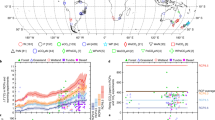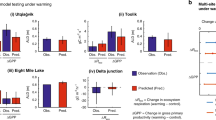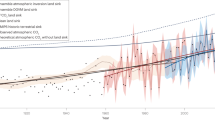Abstract
Disentangling impacts of multiple global changes on terrestrial carbon cycling is important, both in its own right and because such impacts can dampen or accelerate increases in atmospheric CO2 concentration. Here we report on an eight-year grassland experiment, TeRaCON, in Minnesota, United States, that factorially manipulated four drivers: temperature, rainfall, CO2 and nitrogen deposition. Net primary production increased under warming, elevated CO2 and nitrogen deposition, and decreased under diminished summer rainfall. Treatment combinations that increased net primary production also increased soil CO2 emissions, but less so, and hence ecosystem carbon storage increased overall. Productivity, soil carbon emissions and plant carbon stock responses to each individual factor were influenced by levels of the other drivers, in both amplifying and dampening ways. Percentage increases in productivity, soil carbon emissions and plant carbon stocks in response to two, three or four global changes experienced jointly were generally much greater than those expected based on the effects of each individual driver alone. Multiple global change drivers had a profound combined influence on observed outcomes that would have been poorly predicted by knowledge of each driver alone. If such interacting impacts of multiple global change drivers on carbon cycling occur widely among ecosystems, accurately projecting biosphere responses to multifactorial global changes will remain a major challenge in the decades ahead.
This is a preview of subscription content, access via your institution
Access options
Access Nature and 54 other Nature Portfolio journals
Get Nature+, our best-value online-access subscription
$29.99 / 30 days
cancel any time
Subscribe to this journal
Receive 12 print issues and online access
$259.00 per year
only $21.58 per issue
Buy this article
- Purchase on Springer Link
- Instant access to full article PDF
Prices may be subject to local taxes which are calculated during checkout




Similar content being viewed by others
Data availability
All the data used in this article are available through the Environmental Data Initiative data repository at https://go.nature.com/3843kVz and https://go.nature.com/38f8s9c.
References
Luo, Y. et al. Modeled interactive effects of precipitation, temperature, and [CO2] on ecosystem carbon and water dynamics in different climatic zones. Glob. Change Biol. 14, 1986–1999 (2008).
Peng, C. et al. A drought-induced pervasive increase in tree mortality across Canada’s boreal forests. Nat. Clim. Change 1, 467–471 (2011).
Brookshire, E. & Weaver, T. Long-term decline in grassland productivity driven by increasing dryness. Nat. Commun. 6, 7148 (2015).
Zhu, Z. et al. Greening of the Earth and its drivers. Nat. Clim. Change 6, 791–795 (2016).
Peñuelas, J. et al. Shifting from a fertilization-dominated to a warming-dominated period. Nat. Ecol. Evol. 1, 1438–1445 (2017).
Hisano, M., Chen, H. Y., Searle, E. B. & Reich, P. B. Species‐rich boreal forests grew more and suffered less mortality than species‐poor forests under the environmental change of the past half‐century. Ecol. Lett. 22, 999–1008 (2019).
Mueller, K. E. et al. Impacts of warming and elevated CO2 on a semi-arid grassland are non-additive, shift with precipitation, and reverse over time. Ecol. Lett. 19, 956–966 (2016).
Bloor, J. M., Pichon, P., Falcimagne, R., Leadley, P. & Soussana, J.-F. Effects of warming, summer drought, and CO2 enrichment on aboveground biomass production, flowering phenology, and community structure in an upland grassland ecosystem. Ecosystems 13, 888–900 (2010).
Kardol, P., Cregger, M. A., Campany, C. E. & Classen, A. T. Soil ecosystem functioning under climate change: plant species and community effects. Ecology 91, 767–781 (2010).
Kongstad, J. et al. High resilience in heathland plants to changes in temperature, drought, and CO2 in combination: results from the CLIMAITE experiment. Ecosystems 15, 269–283 (2012).
Zhu, K., Chiariello, N. R., Tobeck, T., Fukami, T. & Field, C. B. Nonlinear, interacting responses to climate limit grassland production under global change. Proc. Natl Acad. Sci. USA 113, 10589–10594 (2016).
Ainsworth, E. A. & Long, S. P. What have we learned from 15 years of free‐air CO2 enrichment (FACE)? A meta‐analytic review of the responses of photosynthesis, canopy properties and plant production to rising CO2. New Phytol. 165, 351–372 (2005).
Song, J. et al. A meta-analysis of 1,119 manipulative experiments on terrestrial carbon-cycling responses to global change. Nat. Ecol. Evol. 3, 1309–1320 (2019).
Song, J. et al. Elevated CO2 does not stimulate carbon sink in a semi-arid grassland. Ecol. Lett. 22, 458–468 (2019).
Thakur, M. P. et al. Soil microbial, nematode, and enzymatic responses to elevated CO2, N fertilization, warming, and reduced precipitation. Soil Biol. Biochem. 135, 184–193 (2019).
Rich, R. L. et al. Design and performance of combined infrared canopy and belowground warming in the B4WarmED (Boreal Forest Warming at an Ecotone in Danger) experiment. Glob. Change Biol. 21, 2334–2348 (2015).
Reich, P. B., Hobbie, S. E. & Lee, T. D. Plant growth enhancement by elevated CO2 eliminated by joint water and nitrogen limitation. Nat. Geosci. 7, 920–924 (2014).
Reich, P. B. & Hobbie, S. E. Decade-long soil nitrogen constraint on the CO2 fertilization of plant biomass. Nat. Clim. Change 3, 278–282 (2013).
Adair, E. C., Reich, P. B., Hobbie, S. E. & Knops, J. M. Interactive effects of time, CO2, N, and diversity on total belowground carbon allocation and ecosystem carbon storage in a grassland community. Ecosystems 12, 1037–1052 (2009).
Reich, P. B. et al. Plant diversity enhances ecosystem responses to elevated CO2 and nitrogen deposition. Nature 410, 809–812 (2001).
Craine, J. et al. Functional traits, productivity and effects on nitrogen cycling of 33 grassland species. Funct. Ecol. 16, 563–574 (2002).
Reich, P. B. et al. Effects of climate warming on photosynthesis in boreal tree species depend on soil moisture. Nature 562, 263–267 (2018).
Albert, K. et al. Effects of elevated CO2, warming and drought episodes on plant carbon uptake in a temperate heath ecosystem are controlled by soil water status. Plant Cell Environ. 34, 1207–1222 (2011).
Morgan, J. A. et al. C4 grasses prosper as carbon dioxide eliminates desiccation in warmed semi-arid grassland. Nature 476, 202–205 (2011).
Dieleman, W. I. et al. Simple additive effects are rare: a quantitative review of plant biomass and soil process responses to combined manipulations of CO2 and temperature. Glob. Change Biol. 18, 2681–2693 (2012).
Rastetter, E. B. & Shaver, G. R. A model of multiple‐element limitation for acclimating vegetation. Ecology 73, 1157–1174 (1992).
Rastetter, E. B., Ågren, G. I. & Shaver, G. R. Responses of N-limited ecosystems to increased CO2: A balanced-nutrition, coupled-element-cycles model. Ecol. Appl. 7, 444–460 (1997).
Leuzinger, S. & Körner, C. Water savings in mature deciduous forest trees under elevated CO2. Glob. Change Biol. 13, 2498–2508 (2007).
Robredo, A. et al. Elevated CO2 alleviates the impact of drought on barley improving water status by lowering stomatal conductance and delaying its effects on photosynthesis. Environ. Exp. Bot. 59, 252–263 (2007).
Jiang, M. et al. The fate of carbon in a mature forest under carbon dioxide enrichment. Nature 580, 227–231 (2020).
Cantarel, A. A., Bloor, J. M. & Soussana, J. F. Four years of simulated climate change reduces above-ground productivity and alters functional diversity in a grassland ecosystem. J. Veg. Sci. 24, 113–126 (2013).
Arndal, M. F. et al. Net root growth and nutrient acquisition in response to predicted climate change in two contrasting heathland species. Plant Soil 369, 615–629 (2013).
Farrer, E. C., Ashton, I. W., Knape, J. & Suding, K. N. Separating direct and indirect effects of global change: a population dynamic modeling approach using readily available field data. Glob. Change Biol. 20, 1238–1250 (2014).
Rütting, T. & Hovenden, M. J. Soil nitrogen cycle unresponsive to decadal long climate change in a Tasmanian grassland. Biogeochemistry 147, 99–107 (2020).
Acknowledgements
We thank numerous summer interns for assistance with the experimental operation and data collection and management. This study was funded by programs from the US National Science Foundation (NSF) Long-Term Ecological Research (DEB-0620652, DEB-1234162 and DEB-1831944), Long-Term Research in Environmental Biology (DEB-1242531 and DEB-1753859), Biological Integration Institutes (NSF-DBI-2021898), Ecosystem Sciences (NSF DEB-1120064) and MRI (DBI-1725683), as well as the US Department of Energy Programs for Ecosystem Research (DE-FG02-96ER62291).
Author information
Authors and Affiliations
Contributions
P.B.R. designed the study with assistance from S.E.H., T.D.L. and R.R., and supervised the overall experiment and measurements. R.R. designed the warming facility. R.R. and K.W. conducted the warming manipulations. K.W. supervised the plant and ecosystem measurements and the rainfall treatments. M.A.P. conducted the soil C analyses. P.B.R. analysed the data, with assistance from the other authors. P.B.R. wrote the first draft; all the authors jointly revised the manuscript.
Corresponding author
Ethics declarations
Competing interests
The authors declare no competing interests.
Additional information
Peer review information Primary Handling Editors: Clare Davis; Rebecca Neely.
Publisher’s note Springer Nature remains neutral with regard to jurisdictional claims in published maps and institutional affiliations.
Extended data
Extended Data Fig. 1 Proportion of total aboveground biomass across all treatments for every year for each of the most dominant 11 species.
Species were planted on average in 9/16th of all plots. Solid lines show linear change over time for 9 species (0.11 < P < 0.0001; 0.38 < R2 < 0.94); dashed lines show mean values for two species with no evidence of consistent temporal change (0.5 < P; R2 < 0.07). Note that the proportion axes differ for the C4 grasses versus all of the other species.
Rights and permissions
About this article
Cite this article
Reich, P.B., Hobbie, S.E., Lee, T.D. et al. Synergistic effects of four climate change drivers on terrestrial carbon cycling. Nat. Geosci. 13, 787–793 (2020). https://doi.org/10.1038/s41561-020-00657-1
Received:
Accepted:
Published:
Issue Date:
DOI: https://doi.org/10.1038/s41561-020-00657-1
This article is cited by
-
Patterns and driving factors of soil nutrient stoichiometry under three land use types in the alpine region of Tibet, China
Journal of Soils and Sediments (2024)
-
Combined application of up to ten pesticides decreases key soil processes
Environmental Science and Pollution Research (2024)
-
Lessons learned from farmers’ experience of soil carbon management practices in grazing regimes of Australia
Agronomy for Sustainable Development (2023)
-
The Social-Ecological System of Farmers’ Current Soil Carbon Management in Australian Grazing Lands
Environmental Management (2023)
-
Multi-scale mapping of Australia’s terrestrial and blue carbon stocks and their continental and bioregional drivers
Communications Earth & Environment (2023)



